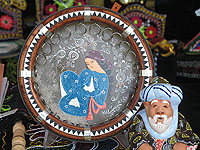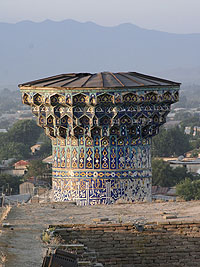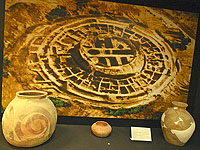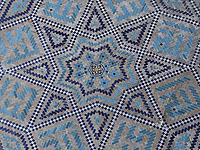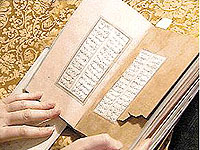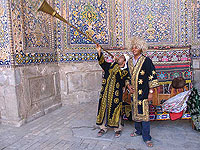 |
|
Uzbekistan Travel |
|||||||||
|
Welcome in Uzbekistan - Xush kelibsizAt the heart of Central Asia, Uzbekistan is situated between the two big rivers, Amu Darya and Syr Darya. It borders on Kazakhstan to the northwest and north, on Kyrgyzstan - to the northwest, on Tajikistan - to the east and southeast, on Turkmenistan - to the southwest, and on Afghanistan - to the south. The territory of Uzbekistan is 448,900 sq. km. It stretches 930 km from north to south, and 1,425 km from west to east. The total length of its borders is 6,221 km. The border regions are: the Usturt Plateau and western shore of the Aral Sea to the north, Termez district of Surkhandarya province to the south, Ferghana Valley to the east, and Usturt Plateau to the west. The territory of the country stretches from southeast to northwest. Uzbekistan's natural world is very diverse. It is composed of desert areas and snowy mountains, rivers and completely dry lands. The most part of its territory lies in the Turon plain, where there are no sudden steep-drops and hills. The Turon plate and mainland, which later became the Tian Shan and Pamir - Alai Mountains, were formed in the Paleolithic period. Later, the sea covered the plate for a long time. The mountain chains are thought to have fully developed during the Alps orogenesis. The mountain ranges blocked the humidity from the Indian Ocean. It caused considerable climatic change: the weather became dry and huge desert areas appeared. As rivers and winds kept changing their directions, the upper layer of soil was continuously displaced from one place to another. It led to the formation of the Kyzyl Kum and Kara Kum deserts. Uzbekistan: ProvincesThe Republic of Karakalpakstan, Uzbekistan: area - 166,6 thousand sq. kmTashkent, Uzbekistan: area - 256 sq. km Andijan Province, Uzbekistan: area - 4,24 thousand sq. km Bukhara Province, Uzbekistan: area - 40,30 thousand sq. km Ferghana Province, Uzbekistan: area - 6,76 thousand sq. km Jizzakh Province, Uzbekistan: area - 21,2 thousand sq. km Kashkadarya Province , Uzbekistan: area - 28, 6 thousand sq. km Khorezm Province , Uzbekistan: area - 6,1 thousand sq. km Namangan Province, Uzbekistan: area - 7,44 thousand sq. km Navoi Province , Uzbekistan: area - 111, 0 thousand sq. km Samarkand Province , Uzbekistan: area - 16,8 thousand sq. km Surkhandarya Province , Uzbekistan: area - 20,1 thousand sq. km Syrdarya Province , Uzbekistan: area - 4, 3 thousand sq. km Tashkent Province, Uzbekistan: area - 15,6 thousand sq. km. Uzbekistan: ArchitectureUzbekistan is a country of ancient high culture with its exceptional architectural patterns. Famous historians of the East in their writings on the ancient cities such as Bukhara , Samarkand and Khiva and other places mention palaces of the rulers, places of residence of aristocracy, market places, madrasah, mausoleums, and describe them as very beautiful with evergreen gardens. The Kyrk-Kyz ('Forty Girls') mansion in Termez dating back the 9th- 10th centuries is a fine example of an original country manor. The Samanids Mausoleum in Bukhara still stands as a fine architectural building from the marvelous period of early Middle Ages. In the llth-12th centuries, Samarkand became one of the major cities in the region. There was intensive construction of attractive houses, civil and religious buildings. The growth of cities, increase of the urban population, and expansion of internal and international trade routes caused construction of many caravansaries (an inn for caravans) near the cities. The Raboti-Malik, the caravansary near Navoi, still stands as a fine example. It was a large structure where dozens of caravans could be accommodated at the same time. Among the city structures, a number of urban places, such as mosques and praying houses were designed with special attention. The Khakim at-Termizy Mosque was viewed as simple, yet a highly valuable and beautiful architectural building with simplicity to be proud of. For many buildings a geometric pattern is common which is characterized by a large variety of rich plates with fine art applications over mud bricks. Additional information about architecture of UzbekistanUzbekistan: Decorative-applied artsHandicraft developed in Uzbekistan from century to century, leaving unique products of the unknown foremen with rich arts, imaginations and perfection in Uzbek heritage. Due to the changes of social and economic conditions, handicrafts gradually became the second after industrial productions on an extent of 20th century. Nowadays, in Uzbekistan enormous attention is rendered towards national foremen in the field. The careful attitude towards the traditional cultural values became one of the main ranks of state policy. The revival of handicraft traditions was part of a logical progress, derived from the aspiration to preserve the national culture. In the last years, the government adopted several laws related to the revival of national handicrafts and traditions. A number of the national artists were elected as the academicians of the Academy of Applied Arts of Uzbekistan. A title "0'zbekiston Respublikasi khalq ustasi" legislatively authorized with Faskhitdin Dadamukhammedov becoming the first handicraft to be called so. At the research and production center "Mitsavvir" (artist) the association of the national artists "Khunarmand" (skillful craftsman) was formed, the divisions of which operates nationwide. The main aim of these organizations is restoration of forgotten section of art history, assistance to the handicraftsmen in manufacturing and sales of production. Additional information about decorative-applied artsUzbekistan: Milestones of HistoryHistory and modernity, the past and the present are unbreakable. They are the link to which are strung the events of the past, like pearls. From early generations down to the latest, stories and myths are told, traditions and customs are taught, and documentary evidence of the past is passed on. Each epoch leaves behind monuments in the form of cities that existed before and also works of art. And all this comprises the foundation of people's inheritance, their historical property. Uzbekistan is a country of an ancient civilization. There are thousands of monuments of archaeology and architecture preserved on its territory. Numerous manuscripts and items of both ancient and recent past of the area are kept in research centers and museums. In recent years, significant changes have been observed with regard to the true historical past of the area, spiritual values and traditions of the people that inhabited the region. Thus, a deep and objective study of the history of the peoples of Uzbekistan, based on first-hand sources, now has been launched in the country. National festivals and rituals have been revived, freedom of faith is fully maintained, and the national self-conscience and dignity of the peoples now residing in Uzbekistan have been recovered. Additional information about history of Uzbekistan Uzbekistan: LiteratureThe most ancient samples of the Uzbek literature concern to poetic creativity, integral part of culture of the Uzbek people. The large place belongs to fair)' tales such as about the animals, magical- fantastic themes and household stories. Among the latter a latifa ('jokes') genre is developed. The national imagination created a collective image of Nasriddin Afandi, the main hero and wise character of Uzbek national jokes. The largest genre of the Uzbek folklore is dastan ('poem'). It was executed usually in support of musical tools. There are more than 300 dastans (100 plots) were written down. The brightest samples are: the heroic epic of"Alpomysh", heroic- romantic epic of "Gur-ughli" (more than 40 plots), military epic "Ynsuf and Akhmad", "Tokhir and Zukhra", and others. The book version, as a rule, was borrowed from classical products "Farkhod and Shirin", "Layli va Majnun". Pre-Islamic culture is represented by insignificant number of written monuments in Old Turkic languages: "Penitential prayer of Manicheans" (the 5th century) and Orkhun-Yenisey writings (7-12th centuries), "Kutadghu-Bilig" ('knowledge', 'giving happiness') (1069) of Yusuf Bolosoghuny, "Khibatul Khakaik" ('a souvenir of truths') by Akhmad Yugnaky, and especially, Devoni Lughati Turk ('dictionary of the Turkic languages) (1072-74) by Makhmud Kashghary are among the finest examples of Uzbek literature. Since the 14th century the Uzbek literature developed intensively and rather diverse. The period saw the emergence of a secular theme (a love epic with Biblical- Quranic topic, "Yusufand Zulaykho" by Durbek in l4-15th centuries.) Additional information about literature of UzbekistanUzbekistan: MusicThe monuments of material culture (cave pictures, monumental sculpture, bas-reliefs, statuettes, and other) and the writings, which have survived up to these days, (from 2nd century AD), testify to the ancient sources of the musical legacy of the Uzbek people. The best samples of musical art have received generalized illumination in the treatises of Central Asian scientists about music (Faraby, Ibn Sina, Khorezmy, Jomy and others). Hereinafter the musical culture of the Uzbek people developed, keeping its originality. Uzbek national and oral-professional music has 4 basic local styles -Khorezm, Ferghana-Tashkent, Bukhara-Samarkand, and Surkhandarya -Kashkadarya, which came as the result of ethnic allocation. Medieval city in the region had a tradition of settling in quarters according to one's occupation. This was common for musicians as well, they lived in the "street of singers", "street of composers" etc. Uzbek songs can be divided into songs of certain times and certain circumstances (ritual - "Yor-Yor", "Kelin salom", calendar - "Navruz", labor - "Mayda", "Yozi", and others), and those executed at any time. Additional information about uzbek music Additional Internet Resources about Uzbekistan Gov.uz - State Authority's Portal of the Republic of Uzbekistan |
